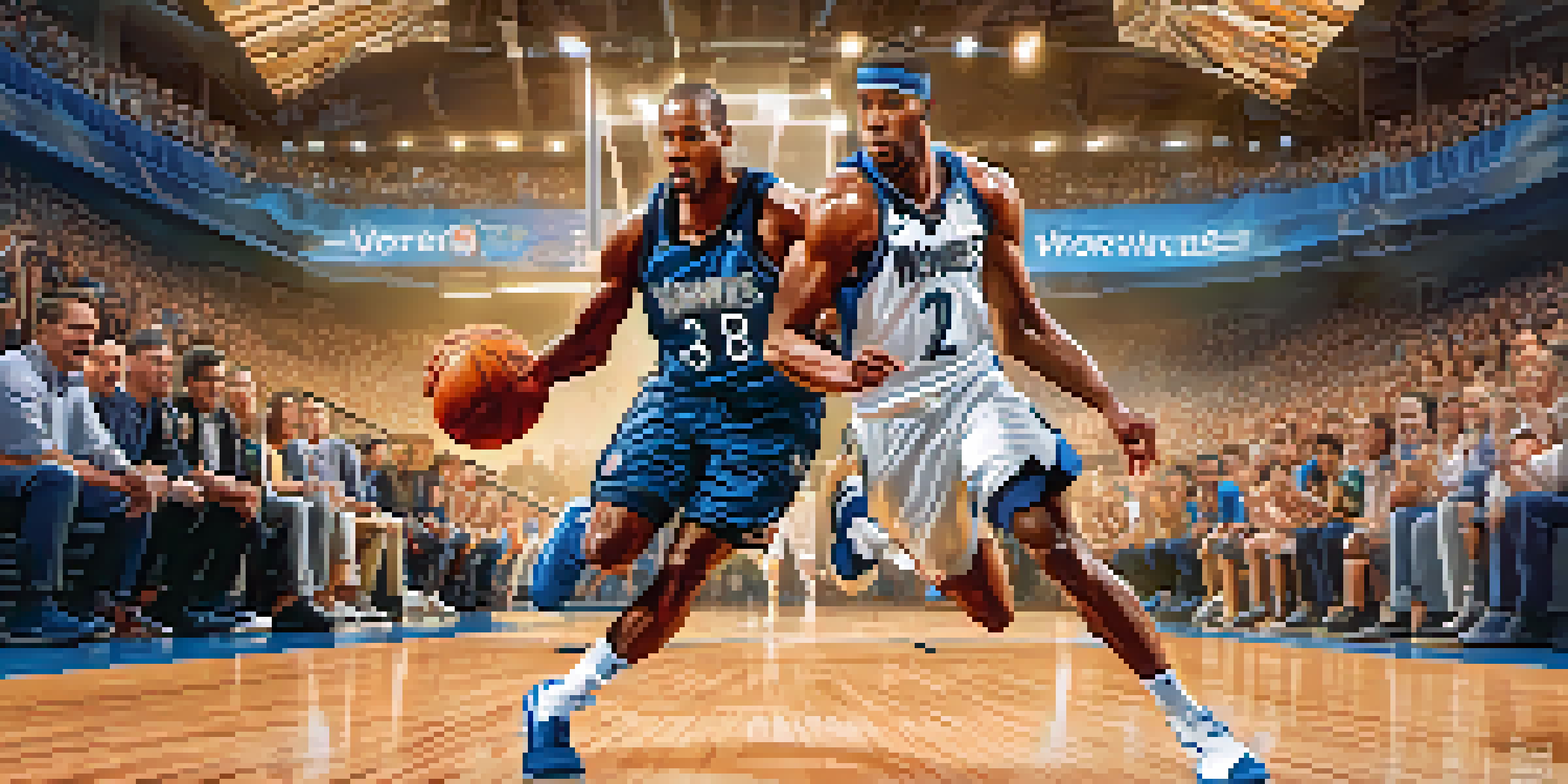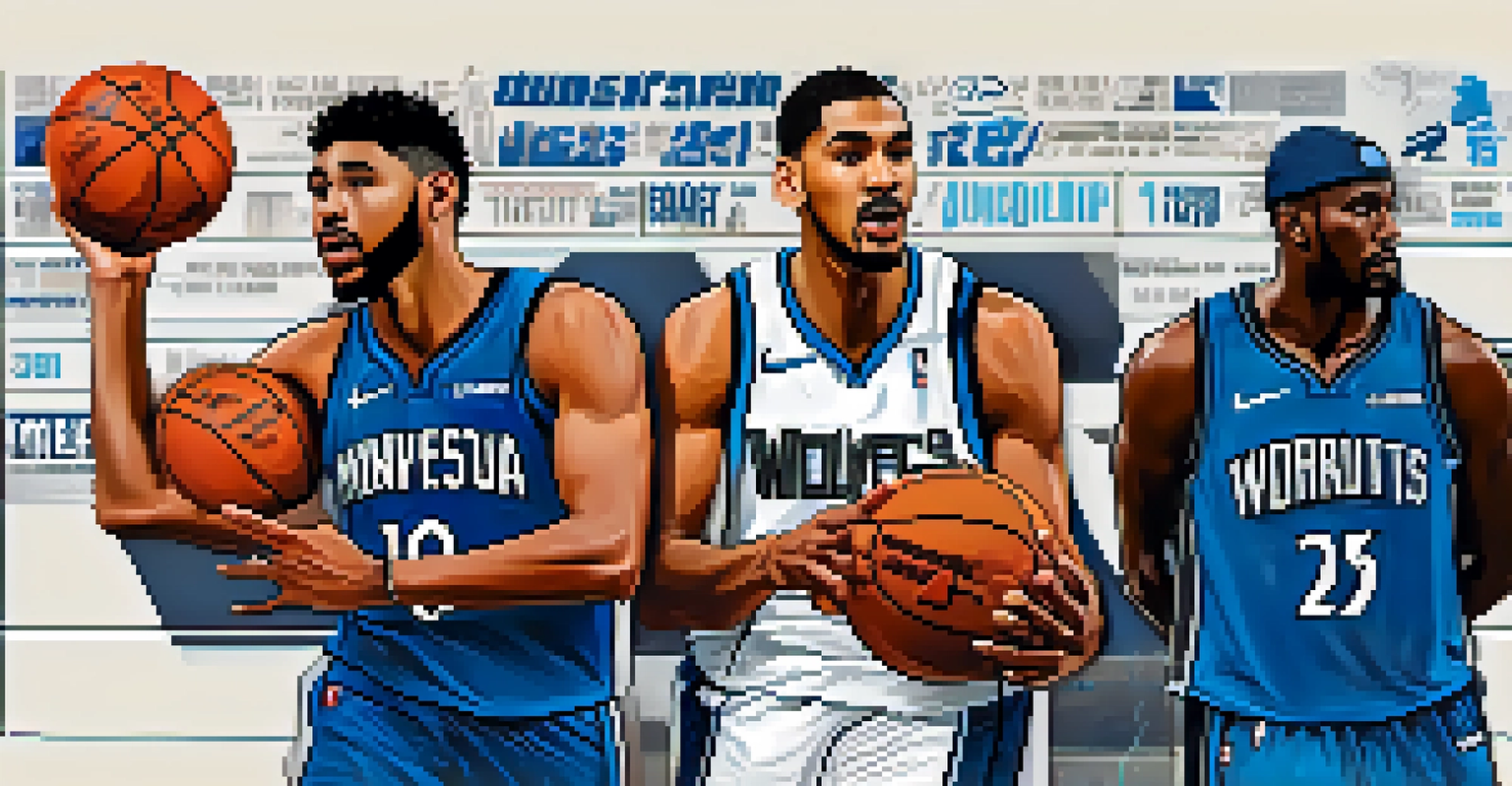Timberwolves Draft History: Building a Winning Team

The Early Years: Establishing a Foundation
The Minnesota Timberwolves entered the NBA in 1989, with high hopes of making a mark. Their first draft pick, Christian Laettner, was a standout at Duke and set the tone for the franchise. While Laettner brought talent, it was the 1995 draft that truly began to shape the team’s identity.
Success is no accident. It is hard work, perseverance, learning, studying, sacrifice and most of all, love of what you are doing or learning to do.
In 1995, the Timberwolves selected Kevin Garnett directly from high school, a bold move that would pay off immensely. Garnett quickly became a franchise cornerstone, showcasing incredible skills and leadership that would carry the team for years. His arrival marked the beginning of a new era, as fans embraced the hope of future success.
This foundational period was essential in establishing the Timberwolves' identity as a team willing to take risks on young talent. The combination of Laettner and Garnett laid the groundwork for a competitive squad, illustrating the importance of making strategic draft choices early on.
The Rise of the 2000s: Drafting for Success
As the 2000s rolled in, the Timberwolves aimed to build around Garnett, leading to significant draft decisions. In 2001, they selected Joe Smith as the first overall pick, although his tenure with the team would be short-lived. The focus on surrounding Garnett with effective players became paramount.

The 2003 draft introduced a pivotal moment for the franchise when they selected Ndudi Ebi, who unfortunately didn't pan out as expected. However, the Timberwolves struck gold in 2004 by acquiring Latrell Sprewell and Sam Cassell, two veterans who would help propel the team to its first playoff success. This mix of youth and experience showcased the importance of a balanced roster.
Timberwolves' Drafting Strategy
The Timberwolves' history showcases the critical role of strategic drafting in building a competitive team.
This period illustrated the Timberwolves' commitment to building a competitive team around their star. While not every pick was a home run, the lessons learned during this time influenced future drafts, emphasizing the need for both potential and proven talent.
The Drafting Drought: Missed Opportunities
The late 2000s and early 2010s were challenging for the Timberwolves, marked by a series of missed draft opportunities. In 2009, they selected Ricky Rubio, a player with immense potential, but his delayed arrival left fans longing for immediate impact. This period saw the franchise struggle to find consistent talent to support Garnett's legacy.
It's not whether you get knocked down, it's whether you get back up.
In 2011, the Timberwolves made another high-stakes choice by drafting Derrick Williams second overall. Unfortunately, Williams never fully realized his potential, leading to further disappointment among fans. These choices highlighted the volatility of the draft process and the fine line between success and failure.
During this drought, many fans were left questioning the team's strategy, as several key players from other drafts blossomed into stars. The Timberwolves' struggles served as a reminder of the unpredictability of the draft, where even the most promising picks can falter.
Rebuilding: A New Era Begins
With the departure of Garnett in 2015, the Timberwolves entered a rebuilding phase that would shape their future. The 2015 draft was significant, as they selected Karl-Anthony Towns first overall, a move that excited the fanbase. Towns quickly emerged as a dominant force, signaling a renewed hope for the franchise.
Following Towns, the Timberwolves made strategic moves in subsequent drafts, including the selection of Kris Dunn in 2016. While Dunn would later be traded, the decision to invest in young talent was clear. The focus shifted toward creating a new team identity built around Towns and emerging players.
Rebuilding After Garnett's Exit
Following Kevin Garnett's departure, the Timberwolves focused on developing young talent like Karl-Anthony Towns to reshape their future.
This rebuilding period was crucial for the Timberwolves, showcasing their commitment to development and growth. By prioritizing draft picks and young talent, the franchise aimed to forge a competitive future, learning from past missteps along the way.
Adding Firepower: The Jimmy Butler Trade
In 2017, the Timberwolves made headlines with a bold trade for Jimmy Butler, aiming to accelerate their competitive timeline. This move brought a seasoned superstar to the roster, providing mentorship for young talents like Towns and Andrew Wiggins. The trade underscored the franchise's ambition to return to playoff contention quickly.
While Butler's impact was immediate, it also highlighted the complexities of team chemistry. The Timberwolves enjoyed a playoff berth in 2018, but the experience exposed some underlying issues within the squad. This era illustrated the delicate balance between nurturing young talent and integrating established stars.
Ultimately, the Butler trade was a defining moment for the Timberwolves, revealing both the potential for success and the challenges that come with it. It reinforced the idea that building a winning team requires not just talent, but also a cohesive vision and strategy.
Young Stars: The Drafting of Anthony Edwards
In 2020, the Timberwolves had the first overall pick again, a chance to reshape their future once more. They selected Anthony Edwards, a dynamic shooting guard with immense potential. Edwards quickly became a fan favorite, showcasing his scoring ability and charisma on the court.
As Edwards developed, he formed an exciting partnership with Towns, creating a formidable duo that raised hopes for the franchise. Their chemistry was evident, and both players demonstrated the potential to lead the Timberwolves back to playoff contention. This marked a new chapter in the franchise's history, one filled with optimism.
Challenges of Team Chemistry
The trade for Jimmy Butler highlighted both the potential for success and the complexities of integrating established stars with young talent.
This drafting decision illustrated the Timberwolves' commitment to investing in young talent while learning from previous experiences. Edwards’ emergence reinforced the importance of aligning the right players to create a competitive roster capable of achieving lasting success.
Looking Ahead: The Future of the Timberwolves
As the Timberwolves continue to evolve, the focus remains on building through the draft while making strategic acquisitions. The combination of experienced players and young stars like Edwards and Towns sets the foundation for a bright future. Fans are hopeful that the lessons learned from past drafts will guide the team's decisions moving forward.
With a commitment to player development and a clearer vision, the Timberwolves are poised to make a significant impact in the coming years. The franchise has begun to establish a competitive identity, and the excitement surrounding the team is palpable. Fans are eager to see how the next draft will shape their aspirations.

In conclusion, the Timberwolves' draft history is a testament to the challenges and triumphs of building a winning team. With a focus on nurturing talent and making calculated moves, the team aims to rise in the ranks of the NBA, creating a legacy that fans can rally around.